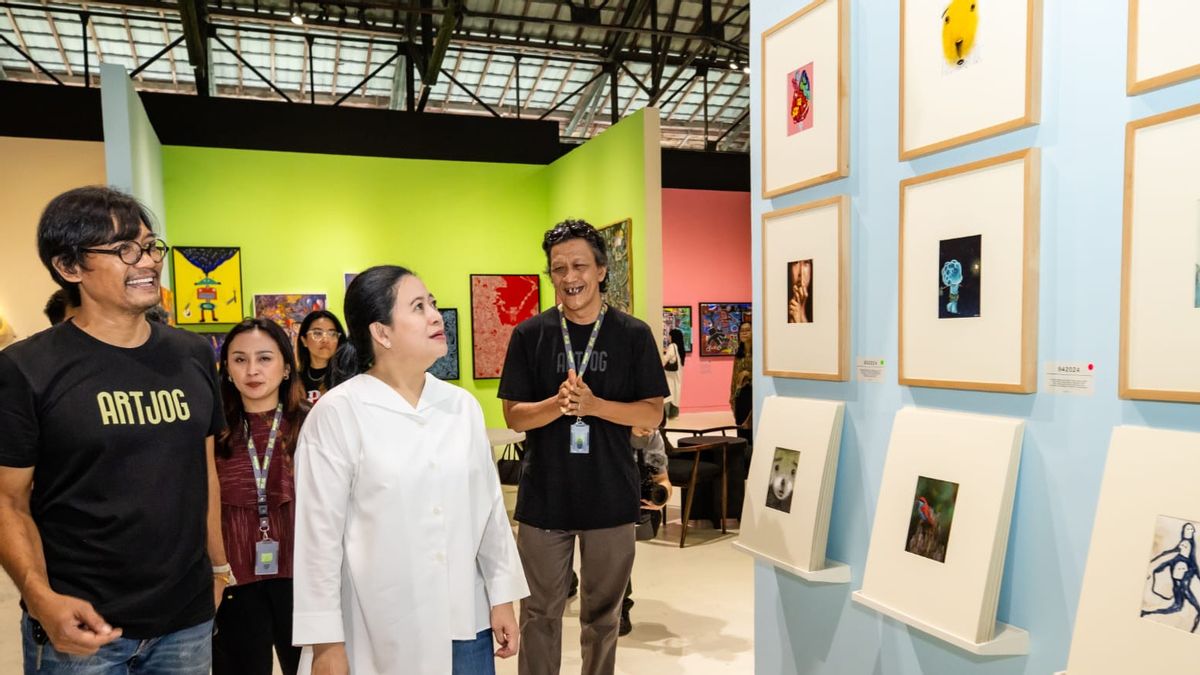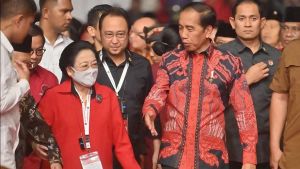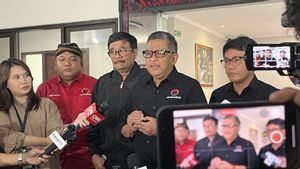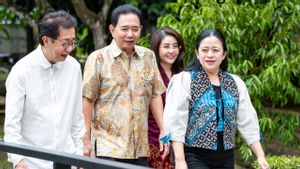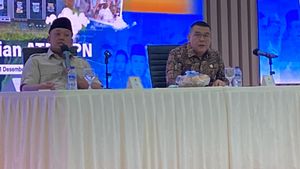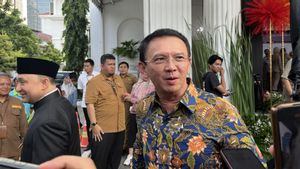JAKARTA - The Speaker of the House of Representatives, Puan Maharani, visited the exhibition, festival, and annual contemporary art market in Yogyakarta known as ARTJOG. Her visit to ARTJOG 2024 was a form of appreciation and support for the artwork of artists, including small artists.
Puan's arrival was to see the works of artists at the 2024 ARTJOG held at the Jogja National Museum, Yogyakarta, Sunday, July 7, guided by the CEO of ARTJOG, Heri Pemadi. Puan was accompanied by Bambang 'Toko' Witjaksono, one of Indonesia's famous graphic artists.
ARTJOG 2024 will be held from June 28 to September 1 with the theme 'Raman' by the curatorial team which means something we imagine will happen in the future, which is close to and far away.
In this year's ARTJOG, there are works of 48 individual adult artists as well as groups from within and outside the country that are displayed. There are also 70 works created by 36 child and adolescent artists who display fresh and filterless perspectives about the world around the community. They were selected from 254 registrants.
When she saw the fine art exhibition at ARTJOG, Puan seemed amazed by the work of Japanese artist Jun Kitazawa who brought back thehayabusa fighter plane into a long-tailed kite that could be flown. Puan even took pictures in the work ahead of Kitazawa.
"Wah luar biasa sekali karya-karyanya itu ya, kita dapat melihat makna dari perspektif setiap individu. Namun secara luas imajinasi para seniman yang membuat karya tersirat yaitu tentang apa yang akan terjadi di masa depan," ucap Puan.
SEE ALSO:
Through this work, Kitazawa brought back the fragments of Japanese occupation history in Indonesia in 1942-1945. On the side of the kite the work featured a collection of memories of old people who experienced colonialism at that time.
"I am very impressed with the work of Jun Kitazawa. The memory of the colonial period at that time made me even more amazed by the heroes who were able to free Indonesia from Japanese colonialists," explained Puan.
Puan also visited the commission works of Agus Suwage and Titarubi which featured interactive installation works with various dimensions and the media. Agus Suwage displays human ear objects as a symbol of a very 'tolerant' sense of hearing in a social space that is considered full of noise.
Meanwhile, Titarubi grows various types of rice accompanied by recordings of prayers, sayings, and praise from indigenous groups of people who can be heard in several rooms, including those in Agus Suwage's work.
Some of the works of other artists that Puan saw include those of Rangga Purbaya, Agus Suwage, Alm Eko Prawoto, Haris Purnomo, and young artist Ramadhan Ali Fatkhur. He also took the time to see the works of 36 child and adolescent artists aged 6-15 years in the ARTJOG Kids area.
The former Coordinating Minister said he was happy to see the beautiful work of little arts. Puan also expressed her pride and hoped that the Indonesian people could continue to support the progress of national art works.
"The artwork of children's artists or the ARTJOG KIDS area is also very interesting and this is one of the faces of Indonesian children who are creative and talented. I am very proud of the work of Indonesian children and we must support their work," he said.
During her visit to DIY, Puan also visited the Animorposa Shibori Jumputan and Batik MSMEs, Gee Baciro. Puan did like the Nusantara wastra-wastra, including batik. Puan's arrival to the Animorposa Shibori Jumputan and Batik Gee Baciro was also her love of batik as well as support for MSMEs.
The Shibori Jumputan animomorphosis is a native MSME from Yogyakarta which is known for its simplicity model. The batik-batik of this MSME is made from the hands of the owner, Anim and her husband named Imam. They started from the metropolitan city to the small city. From a large industry to home crafts.
Interestingly, Animorphosa collaborated with housewives around their gallery to produce handmade shibori which they then made as finished clothes. The women who live around the workshop make shibori in their respective homes so that they can take care of their families while getting income.
"I really like batik and we have to support every form of MSME business that can empower women such as housewives so that it helps Indonesia's economic movement," said Puan.
Meanwhile, Batik Gee Baciro displays batik with different motifs because it combines classical elements and abstract paintings. This technique makes Batik Gee the hallmark of each of his works.
The English, Chinese, Japanese, Arabic, and French versions are automatically generated by the AI. So there may still be inaccuracies in translating, please always see Indonesian as our main language. (system supported by DigitalSiber.id)
